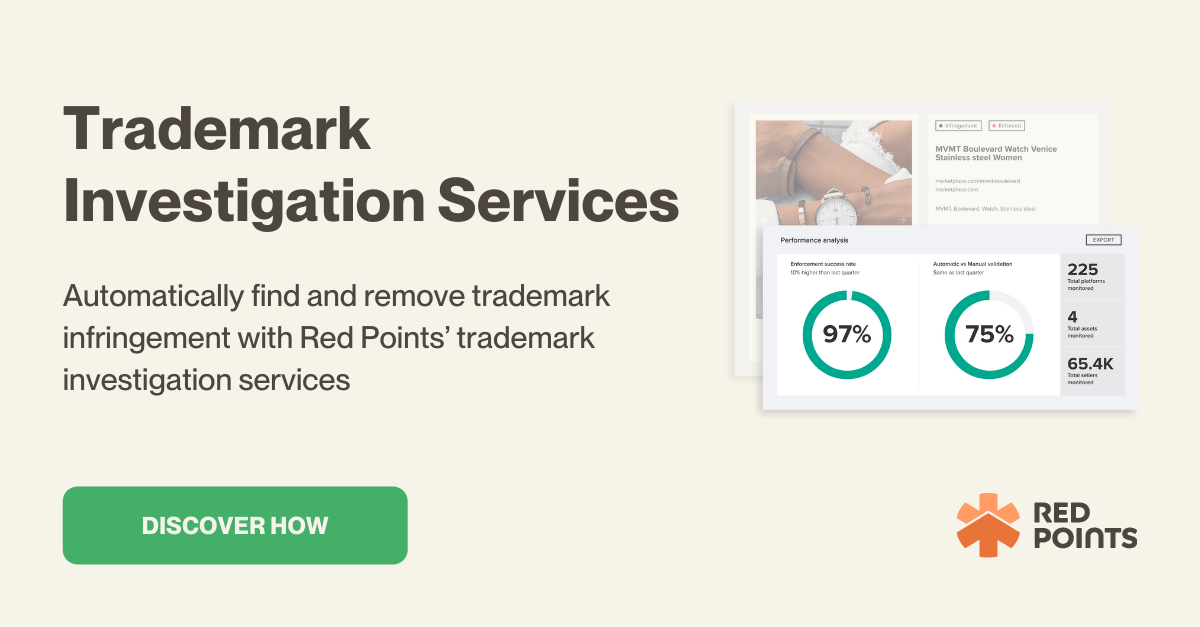The total trade in fake goods now makes up for over 3.3 percent of the total world trade and this number has been steadily increasing.
Counterfeit products are now sold everywhere online, just like authentic products. Tracking down new online counterfeit stores that keep popping up everywhere can be nothing less than challenging.
To make things worse, bad actors actively advertise counterfeit websites as if they were authentic ones in order to lure more customers.
In this article, we discuss:
- How do counterfeit websites operate
- Ways to report websites selling counterfeit goods
- How Red Points helps in shutting down scam websites effectively
How do counterfeit websites operate
Keyword Manipulation
Keyword manipulation occurs when scammers use certain phrases like the brand names or brand’s tagline to increase the popularity of their counterfeit website and its ranking on search engines.
Since it’s easy to get caught when using a brand’s name or its protected keywords, counterfeiters work their way around it and avoid getting caught by misspelling the brand’s name or its tagline a little. They may avoid using the brand’s name altogether and use generic descriptions instead.
For instance, if a scammer is selling fake Chanel bags, using the keyword ‘Chanel handbags’ may be too obvious and lead to them getting caught by the brand quickly. Instead, scammers use keywords like ‘Channel handbags’ or ‘Luxury quilted designer handbags.’
The physical product itself doesn’t change, but scammers modify the text for their product listings to avoid getting taken down.
Image Processing
Counterfeiters use genuine product images for their listings to win new buyers and to also target users when they are image searching. In some cases, scammers might blur out the logo in the image or change the size or color of the product through simple photo editing just to avoid getting caught or get charged with copyright infringement. Removing the logo also allows scammers to bypass crawling automation tools that analyze text present on images.
Blackhat SEO
Blackhat SEO involves using unethical tactics that go against search engine guidelines to manipulate the algorithms and improve the website rankings on the search engine results page for a short term.
While using blackhat SEO can have a negative impact on the website in the long run, scammers don’t care about it. All they want is high search engine rankings for a short span of time to make quick profits.
Geo-blocking
Scammers can also use geo-blocking to avoid getting caught by the original business owners they are trying to counterfeit. Geo-blocking involves blocking access to the website in certain regions or countries.
For instance, if a scammer is trying to sell counterfeit products of a brand that is primarily based in Canada, then they might geo-block their website in Canada to avoid anyone residing in the country from discovering their website.
Paid advertising
Scammers also use paid ads to target branded keywords and rank higher than the original website. This can not only chip away from the search traffic coming to the business’s website but it can also drastically reduce their sales.
4 ways to report websites selling counterfeit goods
1- Report infringement to Google
You can report copyright infringement to Google by filling up their infringement form. You need to choose the Intellectual Property option → Counterfeit → Request removal of the web page.
The form will then ask you to provide details about your company and the copyright/ trademark you own. Though it’s important to note that this process can help you successfully remove websites selling counterfeit products from the search engine results. But the website itself doesn’t get taken down by Google.
2- File a DMCA request against the site
A DMCA (Digital Millennium Copyright Act) request can be filed to shut the website down effectively. You can send the DMCA request to multiple service providers including website host, search engines, and ecommerce platforms. Service providers are required to comply with DMCA standards or they can also be held responsible for the infringed content they are hosting.
3- Submit a UDRP complaint
Uniform Domain-Name Dispute-Resolution Policy (UDRP) complaints can be filed against domain names that are too similar or almost identical to your trademark. While UDRP doesn’t necessarily focus on counterfeit products, it can help you take down websites that are trying to impersonate your brand. UDRP complaints can be considered as the cheaper alternative to litigation, but you will still need an attorney to handle this.
4- Contact your local FBI office
Even if you shut down a website selling counterfeit products, the products themselves still exist. That means, the scammers might eventually pop up again with another website. To avoid playing the game of whack a mole, you can report the suspicions about counterfeit products to your local FBI office in order to track down and effectively seize counterfeits.
What’s next
The longer it takes for you to act against counterfeit listings online, the more impact it will have on your brand reputation.
Actively shutting down websites selling counterfeits as soon as they pop up online is the only way to stop bad actors and scammers from taking advantage of your brand’s success.
Red Point’s Revenue Recovery software can automatically find websites online selling counterfeit products, validate copyright infringement, and trigger automatic takedown processes.
Find, track, and remove counterfeit listings and sellers with Red Points’ Brand Protection software.






